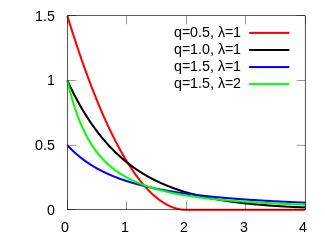q-exponential distribution
|
Probability density function
| |
| Parameters |
shape (real) rate (real) |
|---|---|
| Support |
|
| CDF | |
| Mean |
Otherwise undefined |
| Median | |
| Mode | 0 |
| Variance | |
| Skewness | |
| Ex. kurtosis | |
The q-exponential distribution is a probability distribution arising from the maximization of the Tsallis entropy under appropriate constraints, including constraining the domain to be positive. It is one example of a Tsallis distribution. The q-exponential is a generalization of the exponential distribution in the same way that Tsallis entropy is a generalization of standard Boltzmann–Gibbs entropy or Shannon entropy.[1] The exponential distribution is recovered as .
Originally proposed by the statisticians George Box and David Cox in 1964,[2] and known as the reverse Box–Cox transformation for , a particular case of power transform in statistics.
Characterization
Probability density function
The q-exponential distribution has the probability density function
where
is the q-exponential, if q≠1. When q=1, eq(x) is just exp(x).
Derivation
In a similar procedure to how the exponential distribution can be derived using the standard Boltzmann–Gibbs entropy or Shannon entropy and constraining the domain of the variable to be positive, the q-exponential distribution can be derived from a maximization of the Tsallis Entropy subject to the appropriate constraints.
Relationship to other distributions
The q-exponential is a special case of the generalized Pareto distribution where
The q-exponential is the generalization of the Lomax distribution (Pareto Type II), as it extends this distribution to the cases of finite support. The Lomax parameters are:
As the Lomax distribution is a shifted version of the Pareto distribution, the q-exponential is a shifted reparameterized generalization of the Pareto. When q > 1, the q-exponential is equivalent to the Pareto shifted to have support starting at zero. Specifically:
Generating random deviates
Random deviates can be drawn using inverse transform sampling. Given a variable U that is uniformly distributed on the interval (0,1), then
where is the q-logarithm and
Applications
Being a power transform, it is a usual technique in statistics for stabilizing the variance, making the data more normal distribution-like and improving the validity of measures of association such as the Pearson correlation between variables.
See also
Notes
- ↑ Tsallis, C. Nonadditive entropy and nonextensive statistical mechanics-an overview after 20 years. Braz. J. Phys. 2009, 39, 337–356
- ↑ Box, George E. P.; Cox, D. R. (1964). "An analysis of transformations". Journal of the Royal Statistical Society, Series B. 26 (2): 211–252. JSTOR 2984418. MR 192611.
Further reading
- Juniper, J. (2007) "The Tsallis Distribution and Generalised Entropy: Prospects for Future Research into Decision-Making under Uncertainty", Centre of Full Employment and Equity, The University of Newcastle, Australia
